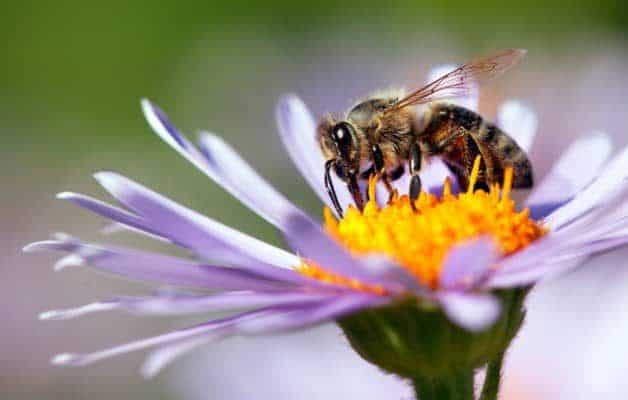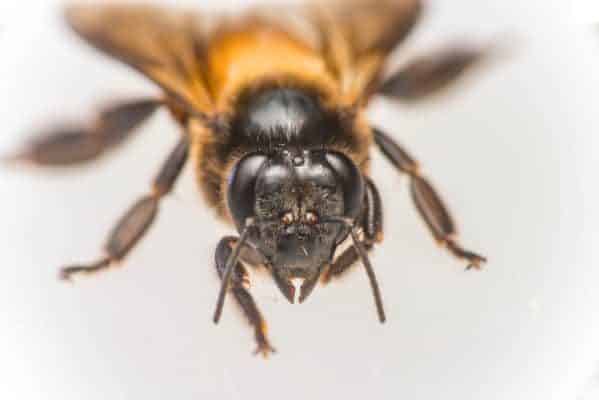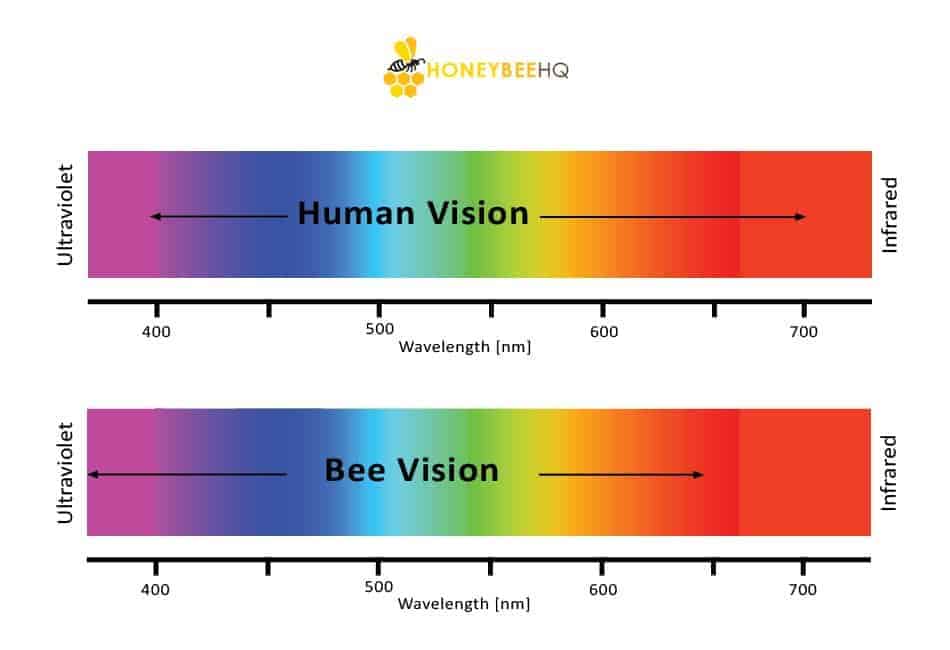
Honey bees are discerning, precise, and particular by nature. They are able to determine the best flowers or blossoms to collect nectar and pollen from. Incredibly, they can travel from significant distances and in unfavorable weather conditions. Bees are also able to locate small flowers and perform precise flight maneuvers in and around these blooms.
This begs the question, How are they able to do this? How many eyes do bees have? How do bees see? And how do bees visually locate flowers so well?
So, how many eyes do bees have? Bees have five eyes, 3 on the top of their head called Ocelli which help with navigation. The other 2, called compound eyes have 6900 facets in each eye, for worker bees. Each facet forms a pixel like part to a larger colour image. Bees however can’t see red, they do see UV light, blue and green.
Let’s take a closer look at how bees see. If you have ever observed how bees operate, how they fly, how they breathe or how they make honey you will already know what amazing little creatures bees are. The bees’ five eyes make up a crucial part of an extraordinary sensory system.
Did you know the honey bees’ eyes can even help them detect changes in wind speed and direction? Stick with me as we delve deeper.
Honey bees have five eyes
Honey bees have two sets of eyes, both performing distinctly different roles. It’s important to remember that bees’ eyes are in no way comparable to the human eye. However, they are perfectly suited to the needs of the bees.
The first set is called ocelli, there are three of these and are located on the top of the bees head. The ocelli eyes don’t give the bee any information on the shape or color of objects. Their role is to measure light intensity.
The single-lens ocelli eye can also see ultraviolet light. The main role of these eyes is to help the bee maintain stability and control during flight. They also help the bees detect predators approaching from above.
The second set of eyes is two large compound eyes. These eyes are far more complex and larger than the ocelli. The compound eyes allow the bees to see shapes and colors. Each compound eye is made up of about 4000 to 5000 facets in worker bees and about 8000 to 10000 facets for the male bees (also known as drones).

The number of facets (Ommatidia) depends on the species of the honey bee for more detail on the facets of each species check out this table that details five species of the honey bee.
Every tiny facet of the compound eye has its own lens connected to a tube containing visual and pigment cells. These little visual systems are called ommatidium. The ommatidium collectively provides a mosaic type vision where each facet of their compound eye creates a piece of the image.
Can bees see better than humans?
The resolution of the bees compound eye is nowhere near as sophisticated as the human eye. To understand, think of the resolution of the bees eye like a digital camera, it would only be about 13 kilopixel. Whereas, scientist Dr. Roger Clark’s research has calculated the resolution of the human eye to be more than 576 megapixels.
So while bees may not be able to see in the high resolution that humans do, their vision is unique to their needs and remarkable at the same time.
What colors can bees see?
To understand what bees can see we are going to explore the biology of the bees eye and make some comparisons of what colors the bees can see compared to humans.
Remember we talked earlier about the worker bee having about 6900 facets to each eye with each one of these facets being a visual system called an ommatidium.
Each one of the ommatidium in the bees’ compound eyes contains nine cells that are sensitive to light which is made up of wavelengths of electromagnetic radiation. The color spectrum is varying wavelengths of electromagnetic radiation that we see as colors.
Out of the nine cells in each ommatidium in the bees compound eye, four of the cells respond to yellow and green light, two respond to blue light and the remaining three to ultraviolet light.
The wavelengths of electromagnetic radiation that determine the colors that both humans and bees see are measured in nanometers. The measurement of the wavelength will determine the color.
The table below has a breakdown of the colors in the spectrum and the corresponding wavelengths of electromagnetic radiation in nanometers.
| Color | Wavelength (nm) |
| Infrared | >740 |
| Red | 625 – 740 |
| Orange | 580 – 625 |
| Yellow | 565 – 580 |
| Green | 520 – 565 |
| Cyan | 500 – 520 |
| Blue | 430 – 500 |
| Violet | 380 – 430 |
| Ultraviolet | <380 |
So what does this mean in regards to what colors bees can see?
In the image below, you can see a comparison of what colors and wavelengths that humans can see compared to that of what bees can see.

You will notice bees and humans have offset ranges of vision on the color spectrum with both of us being able to see orange, yellow, green, cyan, blue and violet. The bees can not see wavelengths above 600 nanometers which means they can not see red.
Bees do however have the ability to see wavelengths below 400 nanometers meaning they can see ultraviolet light, this is their secret weapon when it comes to finding flowers.
As mentioned earlier, in the compound eye of the bee each ommatidium contains three cells that allow the bee to see ultraviolet light. Two of these cells are long with a 180 degree twist down their length with one cell twisting clockwise and the other anticlockwise allowing the two cells to absorb all angles of ultraviolet light equally.
The third cell is shorter and only rotates along its length 40 degrees. This cell provides the bee with the amazing ability to see polarized ultraviolet light. To be able to see polarized ultraviolet light is like the bees’ own built-in GPS. I will explain more about that shortly.
The secret communication between bees and flowers
Now that we know bees can’t see red you may wonder, how do red flowers attract bees? The key is ultraviolet light. Ultraviolet light is the secret communication between flowers and bees that humans can’t see with the naked eye.
Many plants have parts of their flowers that reflect ultraviolet light. Some flowers have distinctive patterns that are reflective to ultraviolet light. As humans, we can’t see any of these ultraviolet signals, but for bees, this is like a bright beacon attracting them to the flower. Check out the video below and you will get a better idea of how amazing flowers look to bees.
Honey bees have a GPS
Well that’s actually not true, honey bees don’t have a GPS as we know it. They do have a truely amazing navigational guide though. As we covered earlier, bees have a cell in each of their ommatidium that allows them to see polarized ultraviolet light.
In fact, studies have suggested that bees are using information from all three of the cells receiving ultraviolet polarized light. This enables the bees to determine the direction of the polarized light.
Bees use this superpower to reliably reference the direction of the polarized light for navigation purposes. Bees use this information like a road map. Foraging bees upon returning to the hive perform their waggle dances to communicate the location of nectar and pollen.
Part of this dance references the direction of the polarized light. This ability to see polarized light is like a GPS leading their fellow bees to targeted food resources to forage.
What’s even better is that polarized light penetrates clouds. This means that even on cloudy days where we can’t see the sun, the bees still have no trouble navigating to foraging locations.
Bees have hairy eyes
The compound eyes of the bee have still more cool features. As we said earlier worker bees have 6900 facets to each of their compound eyes. Well between many of these hexagonal lenses there are tiny hairs.
These tiny hair are believed to deflect wind around the eye. Experiments have shown that these ocular hairs crate an area of stagnant air around the eyes when the bees are in flight. This reduces the airflow over the eye by 90%.
This cool feature of the bees compound eyes virtually stops the build-up of airborne dust and pollen on the facets of their eyes.
Bees have eyes like a high speed camera
The human eye has the ability to recognize movement down to 1/50th of a second. So if a movement is faster the 1/50th of a second the human eye will not pick that up.
If we are to look into a fan, like a ceiling fan possibly in your house, the blades of the fan will seem blurred because our eyes aren’t fast enough to capture a clear picture of the fast-moving blades of the fan.
A bee, on the other hand, can see 6 times faster at 1/300th of a second. So, although vision through a bees eye is not as clear as the human eye their ability to detect movement is far superior to that of the human eye.
This high-speed vision is very handy when trying to locate flowers whilst flying. Particularly when those flowers could be quite small and potentially being blown around by windy conditions.
